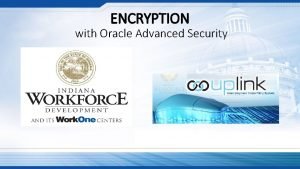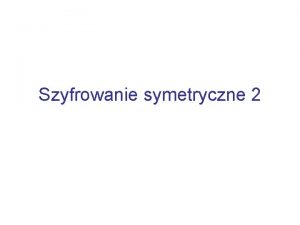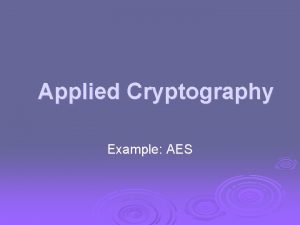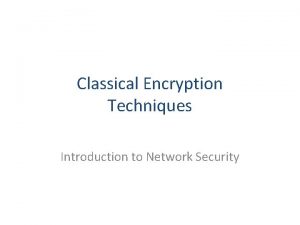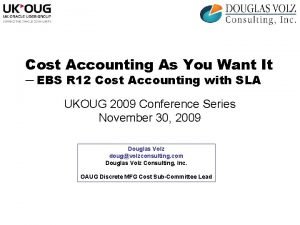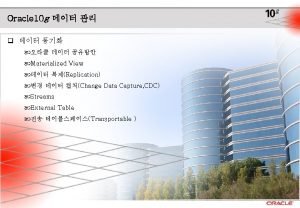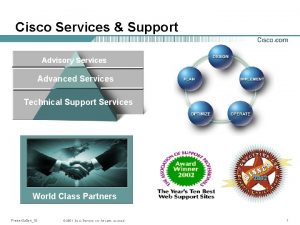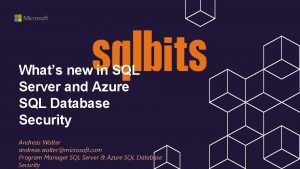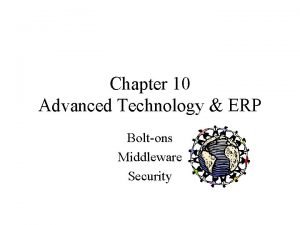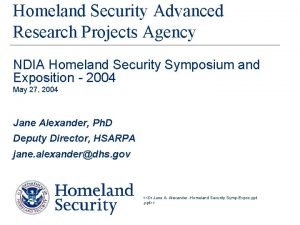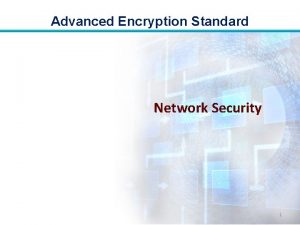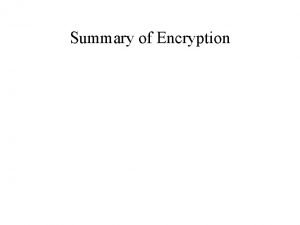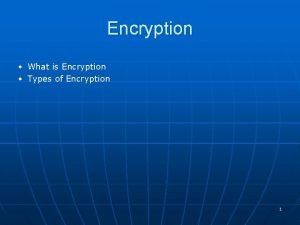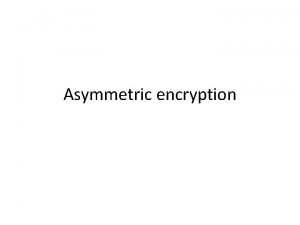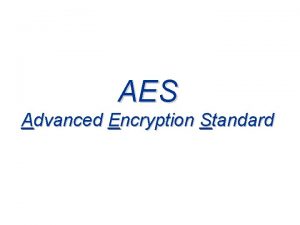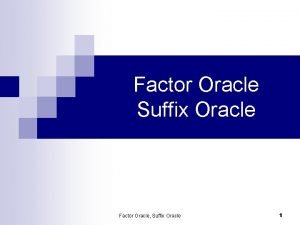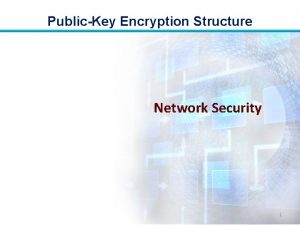ENCRYPTION with Oracle Advanced Security Oracle Advanced Security














- Slides: 14

ENCRYPTION with Oracle Advanced Security

Oracle Advanced Security – Why Encrypt? To protect sensitive data from unauthorized disclosure or use Examples of sensitive data are; • Personally Identifiable Information (PII) • • Social Security Number Name Address Birthdate • Federal Taxpayer Information (FTI) • Information provided by the IRS or other federal agency, to include SSN, etc.

Oracle Advanced Security – Encryption Methods Data should be encrypted both at rest and in transit At rest - protects the data at the disk level so if our actual database files were stolen they would be unreadable. In transit - protects our data as it travels from the source to the database and back

Oracle Advanced Security provides two important controls to protect sensitive data Transparent Data Encryption (TDE) On-the-fly Redaction of Display Data • TDE stops would-be attackers from bypassing the database and reading sensitive information directly from storage by enforcing data-at-rest encryption in the database layer. • Data Redaction complements TDE by reducing the risk of unauthorized data exposure in applications, redacting sensitive data before it leaves the database. Together these two controls form the foundation of Oracle’s defense-in -depth, multi-layered database security solution

Encryption – What we encrypted Oracle allows both Column level and Tablespace encryption Column Level – most useful when sensitive data is limited and confined to very few tables Tablespace Level – should be used when sensitive data exists throughout the database

Encryption – How we decided what type to use We used tablespace level encryption for all of our applications including the ones in the IOT Oracle Shared Environment because: ü This offered the best protection for all data ü The applications were not designed to keep PII in specific tables ü There are restrictions on using Column Level Encryption – see the Oracle Advanced Security Administrators Guide ü Overall performance of the database is better when encrypted and non encrypted data is not mixed

Encryption – Steps taken to Prepare for this task The DBA Team dug into the Oracle Advanced Security Administrator’s Guide. Determined the type of encryption we were going to utilize. • Column level, tablespace level Determined necessary steps encrypt the data • Create a wallet, create encrypted tablespace, import data, etc Created a test plan: • Determined what portion of the online applications we wanted to test • Determined what batch processes we want to test and secured test data • Determined how we were going to gather metrics and measure results

Encryption – Performance Expectations Oracle states in the Oracle Advanced Administrator’s Guide performance could be degraded by up to 8% To determine the impact on our applications, we measured; • On-line SQL statements • Execution times for large queries through on-line interfaces • Execution times for large batch processes • It is important to note that the most important thing to test is batch processing. We were concerned that performance impact would lengthen the nightly batch processing window.

Encryption – What we found • Performance varied between databases. • Some third party software products do not work well with Oracle Encryption and it is stated in their documentation (IBM Filenet, etc) • We did experience some performance impact on very complex SQL • Overall operation of the applications was not affected because; • Hardware was right-sized to absorb some degradation • Data was reorganized as we laid it down into the brand new tablespaces • We ‘tuned’ parts of the database where impact was measurable • It took around 10 hours to do just the encryption work for a 600 GB database (not including backups)

Encryption –Timeline for Production Implementation Start approx. 5: 40 pm on 8/21/15 Approx. 29 hours Finish approx. 10: 00 pm on 8/22/15

Encryption – Implementation Tasks • Scheduled the outage with all key players (Business and Technical) • Completed the production schedule for the day • Shut down all front-end pieces of the applications and put up maintenance pages • Ensured no processes remained connected to the database • Performed 3 back-ups so have multiple ways for a recovery if needed. • MSDOS Cold Backup, RMAN Cold Backup (IOT took these), Full Export • Dropped the appropriate schemas and tablespaces

Encryption – Implementation -- continued • Re-created tablespaces • Re-created the schemas and associated the new encrypted data tablelspaces to them • Imported the data into the new encrypted tablespaces • Brought Applications back-up • Smoke testing performed by test team • Released our system back to the public

Encryption – Costs Involved Licensing • Oracle Advanced Security for our production RAC Clusters cost just over $100, 000 Man Hours • DBA’s – 300 (research and implementation) • Development team - 80 (staging and executing batch tests) • Test Team – 120 (executing scripts, validating results)

Acknowledgements Contributors to our success • DWD Executive team • IOT DBA Team • DWD Test Team • DWD Development Team
 Advanced security oracle
Advanced security oracle Szyfrowanie symetryczne
Szyfrowanie symetryczne Advanced encryption standard example
Advanced encryption standard example Classical encryption techniques
Classical encryption techniques Security security security
Security security security Oracle advanced cost accounting
Oracle advanced cost accounting Oracle advanced queuing
Oracle advanced queuing Reduce storage oracle
Reduce storage oracle Oracle r
Oracle r Oracle advanced replication
Oracle advanced replication Cisco umbrella presentation
Cisco umbrella presentation Sql threat protection
Sql threat protection Advanced application and middleware security
Advanced application and middleware security Advanced facility management services
Advanced facility management services Homeland security advanced research projects agency
Homeland security advanced research projects agency
